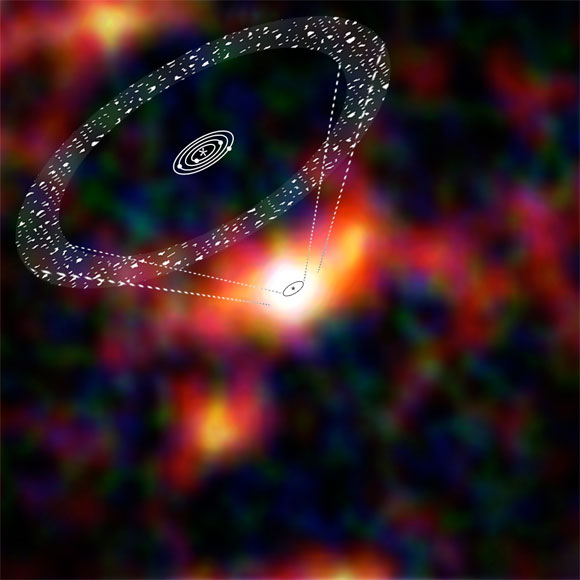The comet ring around GJ581’s planetary system is most likely similar to our Kuiper belt, located beyond the orbit of Neptune, and made up of the “fossilized” remnants left after the planets formed. Bombardment of the inner solar system by these ice rich comets soon after its formation, brought water to the Earth to make its oceans, as recently shown with Herschel space telescope. The discovery of a disc around the star GJ581, over two billion years old, is particularly interesting in this context. Two of the planets are located in the so-called « Habitable Zone » : meaning that their temperature is such that any water present would be liquid. Thus, by analogy with the history of the solar system, this disc could be a water reservoir which, over the lifetime of GJ581, could have furnished water to these planets. And according to current knowledge, life as we know it was born in the ocean.

This is the first time that astronomers have definite proof of a ring of debris around a “mature” red dwarf star ; that is just what they have been looking for. « Stars of this type are the most numerous in the Galaxy, but they are also the least luminous, which renders this quest somewhat difficult », explains Jean-François Lestrade, CNRS Research Director at the « Laboratoire d’étude du rayonnement et de la matière en astrophysique – LERMA » of the Observatoire de Paris, lead author of this work, which involved an international team. The deed was possible thanks to the unprecedented sensitivity in the infra-red domain of the Herschel space telescope.
From an analysis of the images of the disc, the astronomers have been able to determine that the inner edge of the belt must be at a distance of roughly 25 times the distance of the Earth from the Sun . This measurement provides the scale of the whole planetary system which could orbit the star GJ581, but which for the time being is only known to have four planets on orbits smaller than that of Mercury around the Sun. The astronomers have reasons to believe that there is at least one more distant planet which would be responsible for dynamical pertubations in the disc creating the observed dust.
Finally, it has been shown quite recently that the rings of dust and debris which can be seen around stars like the Sun are generally associated with super-Earths, rather than with giant planets like Jupiter. This renders the system more stable. The environment around GJ581 seems consistent with this result : this is the first suggestion that the mecanism which controls the mass of discs around solar-type stars could also be operating in the case of the numerous red dwarfs in the Galaxy.
Herschel in a nutshell
The infrared space telescope Herschel is a scientific satellite managed by the European Space Agency ESA. Its instruments were furnished by various consortia under European leadership, with an important contribution from NASA. The French space agency CNES, working with various laboratories and research organizations, contributed financially, and in the construction of instruments as well as in the analysis of the data they produced.
Reference
“A debris disk around the planet-hosting M-star GJ 581 spatially resolved with Herschel” published in the Astronomy & Astrophysics journal, November 27, 2012.
1 The space telescope Herschel is named after the physicist William Herschel who discovered infrared radiation in 1800. Herschel, launched in 2009, is thus the name of the larges space telescope woring in the infrared and submillimetre domains. To know more about the French participation in Herschel
2 See the press release « Comète Hartley 2 - Herschel : nouveau regard sur l’origine des océans terrestres »
3 Le Laboratoire d’Étude du Rayonnement et de la Matière en Astrophysique - LERMA is a scientific department of the Observatoire de Paris and a « unité mixte entre l’Observatoire de Paris, le CNRS, l’Université Cergy-Pontoise, l’UPMC-Université Pierre et Marie Curie et l’ENS ».
4 The distance of the Earth from the Sun is about 150 million km ; the average Earth-Sun distance is called an astronomical unit.
Science contact
– Jean-François Lestrade
CNRS Research Director
LERMA
Observatoire de Paris
01 40 51 21 37
Press contact
Observatoire de Paris
– Frédérique Auffret
01 40 51 20 29

Figure 3 : Gradient du profil radial du signal à 21 cm, à z=11.05, pour une simulation de 280 Mpc comobiles de côté. La courbe noire se réfère à la première source apparaissant dans la simulation, sans ajout de bruit instrumental. La courbe rouge se rapporte à la même source, mais après avoir ajouté du bruit. Quant à la courbe bleue, c’est celle du gradient du profil lorsque toutes les sources de la simulation ont été sommées ensemble. Cette méthode de moyenne est efficace, puisqu’elle permet de mettre en évidence les horizons Lyman-delta et Lyman-epsilon (pics du gradient, indiqués par des flèches), alors que ceux-ci ne sont pas détectables sur les profils individuels, bruités ou non.
|
| Download the press release (pdf) |


![<multi>[fr]pdf[en]pdf</multi>](IMG/gif/pdf.gif)